
|
|
|
|
 |
|
Home Site Search Contact Us Subscribe
|
|
|
|
Rethinking Form and Function: Swarthmore College Unified Science Center by Einhorn Yaffee Prescott and Helfand Architecture
Swarthmore, PA: A "green" science center becomes an intellectual and social magnet for an entire campus. by ArchNewsNow July 19, 2005 Responding to an urgent need to update and expand its science teaching facilities, Swarthmore College sought to create a contemporary environment to express the College’s commitment to progressive education and intellectual inquiry while respecting their rich architectural heritage of sober, stone campus buildings integrated into an extraordinary landscape setting. “Architecture is vitally important in expressing this tradition as well as inspiring imagination and creativity,” says its president, Alfred Bloom.
The College’s outdated science facilities needed more than a renovation and additional space; the departments required new technology and a multi-disciplinary teaching environment. The Boston office of Einhorn Yaffee Prescott and New York City-based Helfand Architecture have created a true unified science center, transforming isolated departments into a social and intellectual gathering place for the entire campus. The individual science buildings and library are now interconnected through a series of laboratory blocks, lecture halls, study areas, and courtyards. Located at the center of the complex is a commons with inviting transparent walls and “butterfly”-shaped roof.
The $48.2 million center, which includes 60,000 square feet of renovated space and 80,000 square feet of new building, is placed at the north end of the campus to form the fourth edge of the academic quadrangle. The new forms wrap around the existing buildings to link the existing individual science buildings and library. A series of interconnected gardens between the existing and new masses provide views, light, and air into all parts of the building, and lead out to the wooded preserve north and west of the site. The new complex creates a dialogue with Kohlberg Hall, a humanities building at the south side of the quadrangle designed by Helfand Architecture in 1996, and completes the north campus quad envisaged in the master plan completed by Helfand Architecture and Ehrenkrantz Eckstut and Kuhn in 1994.
To respect the scale of the campus, the new unified science center is broken down into separate masses linked with a series of special connector elements. The heights are kept low at two and three stories, with a sunken garden that spills out into the woods allowing views over the new building to the woods. Local schist stone laid in an ashlar pattern ties the building into the fabric of the campus, while modern forms and detailing are employed throughout the new building. The connector elements share details to link together the large building while breaking down the scale: hovering butterfly-shaped roofs supported on a single line of columns; standing seam metal cladding; and concrete pylons. Two larger lecture halls, clad in local schist stone and rotated at 12 and 18 degrees, reinforce the turning at the corner of the quad and contrast with the rectilinear lab buildings that are sheathed in abstract patterns of honed granite façade panels.
The largest connector element uses the corner to connect the west and north sides of the quad. This hinge element acts as a primary entrance and provides a student commons with a coffee bar. A V-shaped roof flies over the seating area, held up by wood beams balancing on trapezoidal concrete pylons. Glass curtainwalls open up south to the quad and north to the woods and allow views through the commons. At night, the light spills out onto the campus, acting as a marker and beacon. Warm, natural materials suffuse the space: exposed wood beams and wood decking on the ceiling, slate flooring, and smooth concrete pillars.
Sustainability was a driving factor from conceptual design through implementation. Consistent with Swarthmore’s commitment to teaching social responsibility, the College encouraged the design team to make sustainability the muse of the design – and visible. A Green Team was formed to guide the creation and implementation of a green master plan, resulting in an expected Silver LEED certification (application pending), one of the first lab buildings to qualify at this level.
The green strategy includes many features such as a zero runoff environment to protect the adjacent woods from erosion by harvesting rainwater in the huge, iconic V-shaped roofs, directing water back into the earth through waterfalls, stone water channels, re-absorption pools, and infiltration beds with excess stored underground for irrigation. In another green strategy, rather than demolish and replace the outdated wet lab buildings, the design incorporates them in the new complex, re-using the space for “dry” labs for physics and astronomy, math and statistics, and computer science. Local and recycled materials are featured throughout the building, and gauges illustrating current utilization of energy and other utilities are a focal point in the snack bar area. The science center also pioneers the use of fritted glass for curtainwall glazing to prevent bird collision – an important innovation that has received recent worldwide media coverage as a model for sustainable design, including the new sustainable design guidelines for the World Trade Center site in Lower Manhattan.
Learning spaces include departmental “living rooms” where students and faculty can gather in a lounge setting for informal discussions or group study, alcoves within the corridors with lounge seating for interdisciplinary interaction, and study nooks adjacent to circulation for individual or group study at tables. All lounge spaces are fitted with adjacent floor to ceiling blackboards for “chalk talks”.
Among the most unusual features, however, are the outdoor teaching spaces scattered around the perimeter of the building where honed black granite walls provide “blackboards” so that science classes can be conducted with a traditional teaching wall, allowing for the cultural tradition so closely identified with Swarthmore’s humanities departments where outdoor classes and seminars have been taught for decades.
The new science center has become a magnet that fosters intellectual and social interaction among faculty, science students, and the larger college community.
See also: “New Swarthmore buildings marry tradition and modernity” by Inga Saffron, Philadelphia Inquirer, March 11, 2005.
Helfand Architecture, established in 1981, has gained recognition for its sustainable design solutions for projects ranging from institutional to high-end commercial and residential. Many involve integrating new uses for old buildings within an existing context. Recent and current design projects include: Automated Trading Desk Headquarters, Charleston, SC; Kohlberg and Trotter Halls at Swarthmore College; and a number of library projects for New York City.
Einhorn Yaffee Prescott (EYP), an integrated architecture and engineering design firm, specializes in high-end college and university, science and technology, government facility, K12, and historic/landmark preservation and restoration projects. With more than 400 employees located in Albany and New York, NY, Boston, MA, and Washington, DC, the firm is ranked among the largest A/E firms in the nation by Building Design & Construction.
Project Credits
Owner: Swarthmore College, Swarthmore, PA Design Team: Cahal Stephens (EYP Principal-in-Charge); Margaret Helfand (HA Design Principal); Kip Ellis (EYP Project Manager); Jennifer Stevenson Tulley / John Tinmouth, HA, Lila Kahlvati, EYP (Project Architects); Yelena Lembersky, Jay Hallinan, Nikolas Dando-Haenisch (EYP), Elisa Testa, Tom Chang (HA) Interior Design: Helfand Architecture (public spaces, lounges); Einhorn Yaffee Prescott (classrooms, labs, offices) Additional Design Team (EYP): Mary Killough, Michele Webb Structural Engineer: Christakis VanOcker Morrison Mechanical & Electrical Engineer: Einhorn Yaffee Prescott EYP MEP Team: Ralph Gifford, William Shosho, James Boyle, Brian Johnson, Andy Hebert, Ryan Peters, Kieran Guinan, Jeff Dufford, Rob Ahearn Plumbing Engineer: Robert W. Sullivan, Inc. Civil Engineer: Gladnick Wright Salameda Landscape:
ML Baird & Co Landscape Architecture Audio
Visual: CMS Innovative Consultants & FutureSys Design Photography: Jeff Goldberg / Esto Photographics Inc.
Metal/glass
curtainwall, doors, entrances: Kawneer Aluminum:
Wausau Doors: Phillip Manufacturing Corp. (metal);
Marshfield Door Systems (wood); Technical
Glass Products Pilkington (fire-control doors, security grilles); Best
Access Systems (hardware/locksets); Stanley
(hinges); LCN Closers; Von Duprin (exit devices); Burns (pulls) Flooring:
Pyramid Brand Pennsylvania Slate; Mannington (resilient); Monterrey Carpets
|
(click on pictures to enlarge) 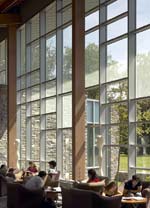 (Jeff Goldberg/Esto) Swarthmore College Unified Science Center: Commons interior with fritted glass panels (Jeff Goldberg/Esto) Linked pavilions of the Science Center embrace North Campus Quad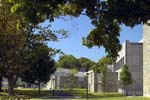 (Jeff Goldberg/Esto) Gateway into North Campus from Visitor Parking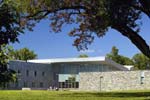 (Jeff Goldberg/Esto) Science Commons with butterfly roof to harvest rainwater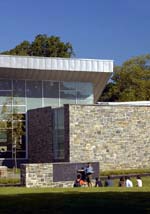 (Jeff Goldberg/Esto) Outdoor teaching amphitheater with honed granite “blackboard”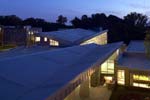 (Jeff Goldberg/Esto) Butterfly roofs over Commons and entry to courtyard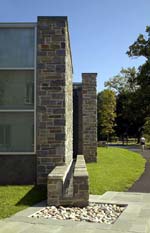 (Jeff Goldberg/Esto) Waterfall, raised water channel and infiltration bed for harvesting rainwater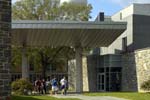 (Jeff Goldberg/Esto) Entry to courtyard with existing science buildings beyond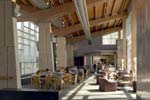 (Jeff Goldberg/Esto) Science Commons with butterfly roof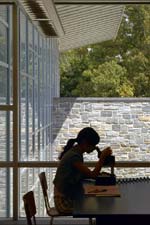 (Jeff Goldberg/Esto) Biology lab overlooking Commons entry plaza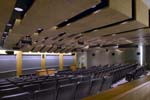 (Jeff Goldberg/Esto) 200 seat lecture hall with bronze-dusted OSB panel ceiling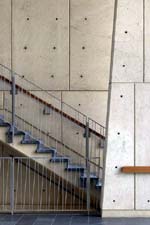 (Jeff Goldberg/Esto) Commons stair and pylon detail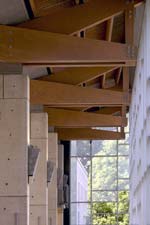 (Jeff Goldberg/Esto) Commons cantilevered roof detail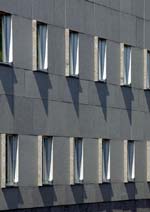 (Jeff Goldberg/Esto) Laboratory wing granite curtain wall with window shading fins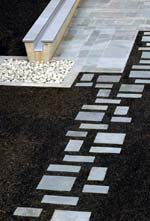 (Jeff Goldberg/Esto) Pathway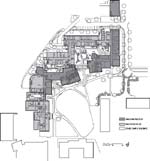 (Einhorn Yaffee Prescott/Helfand Architecture) Site plan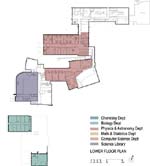 (Einhorn Yaffee Prescott/Helfand Architecture) First-floor plan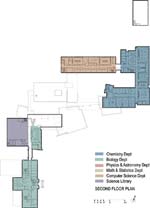 (Einhorn Yaffee Prescott/Helfand Architecture) Second-floor plan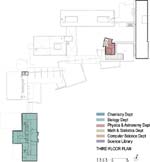 (Einhorn Yaffee Prescott/Helfand Architecture) Third-floor plan |
© 2005 ArchNewsNow.com